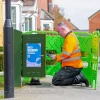The March 2015 BDUK and BT “Fibre Broadband” Uptake Figures
The Government’s Broadband Delivery UK project, which is predominantly working with BT to deploy superfast “fibre broadband” (FTTC/P) services across the United Kingdom, has published the programmes latest take-up figures for March 2015. Adoption continues to rise and more projects are now touching the 20% claw-back threshold.
Readers might recall that we published the first uptake summary just before Christmas using September 2014 Data and then the second update was posted a few months later using the December 2014 Data, which revealed that Hampshire, Surrey, North Yorkshire and Rutland had all broken the 20% uptake milestone.
Advertisement
Understanding uptake is important because most of the related BDUK contracts have a claw-back mechanism, which means that take-up beyond 20% (this figure may vary between contracts) could trigger a return of some of the original investment and that can then be used to extend coverage or improve service performance.
As before the following figures only reflect uptake in areas that have been upgraded through the BDUK and related state aid schemes, thus they do not include uptake achieved through purely commercial deployments (e.g. BT’s separate £2.5bn roll-out of FTTC/P to the first 66% of the United Kingdom or Virgin Media’s cable network).
The good news is that BDUK’s latest March 2015 data shows that Cambridgeshire, Peterborough (19.5%), Herefordshire and Gloucestershire (20.3%) and Northamptonshire (21.3%) have now effectively passed the all-important 20% threshold and others are closing fast.
BDUK Phase 1 Take-up Data (March 2015) – %
Berkshire Councils – 11.2
Buckinghamshire and Hertfordshire – 15
Cambridgeshire, Peterborough – 19.5
Central Beds, Bedford Borough, Milton Keynes – 13.4
Cheshire East, Cheshire West & Chester, Warrington, Halton – 16.1
Devon & Somerset (including, Plymouth, Torbay, North Somerset, Bath & NE Somerset) – 13.3
Coventry, Solihull, Warwickshire – 15.9
Cumbria – 17.3
Derbyshire – 9.1
Dorset, Bournemouth and Poole – 12.9
Durham, Gateshead, Tees Valley and Sunderland – 11.3
East Riding of Yorkshire – 8
East Sussex, Brighton and Hove – 13.9
Essex, Southend-On-Sea, Thurrock – 11.2
Greater Manchester – 8.5
Hampshire – 17.6
Herefordshire and Gloucestershire – 20.3
Isle of Wight – 6.5
Kent and Medway – 13.7
Lancashire, Blackpool, Blackburn with Darwen – 14.3
Leicestershire – 10.4
Lincolnshire – 12.9
Merseyside – 6.7
Newcastle upon Tyne – 5.8
Norfolk – 14.9
North Lincolnshire, North East Lincolnshire – 15.3
North Yorkshire – 23.5
Northamptonshire – 21.3
Northumberland – 16.1
Nottinghamshire – 9.7
Oxfordshire – 16.2
Rutland – 39.8
Shropshire – 16.9
Staffordshire and Stoke-on-Trent – 10.7
Suffolk – 17.1
Surrey – 27.1
West Sussex – 14.9
West Yorkshire – 10.7
Wiltshire, South Gloucestershire – 18.7
Worcestershire – 12.5Devolved Administrations
Highlands and Islands – 11.6 (up from 10.3% in Dec 2014)
Northern Ireland – 8.5 (up from 0.4% in Dec 2014)
Rest of Scotland – 10.8 (up from 8.7% in Dec 2014)
Wales – 13.7 (up from 12.7% in Dec 2014)
Take note that uptake is a dynamically scaled measurement, which means that at certain stages of the scheme it may go up or down depending upon the pace of deployment and other factors; but over time the direction should only go upwards. Likewise several of the projects report far lower uptake, usually because they only began fairly recently.
Advertisement
Some of the other issues that can impact uptake include higher prices for FTTC/P services (less attractive), consumers being locked into long contracts with their existing ISP (can’t upgrade yet), a lack of general availability awareness or interest in the new connectivity (i.e. if you have a decent ADSL2+ speed then you might be less inclined to upgrade) and concerns over the ease of migration.
Overall the results are positive and appear to be running well ahead of the Government’s initial predictions, not that this would be too difficult with some early projections expecting considerably less (here and here). NOTE: BDUK recently reported that 2.5 million premises had been covered by the work up to March 2015 (here).
Mark is a professional technology writer, IT consultant and computer engineer from Dorset (England), he also founded ISPreview in 1999 and enjoys analysing the latest telecoms and broadband developments. Find me on X (Twitter), Mastodon, Facebook, BlueSky, Threads.net and Linkedin.
« North Yorkshire UK Completes Phase 1 Superfast Broadband Rollout


















































Comments are closed